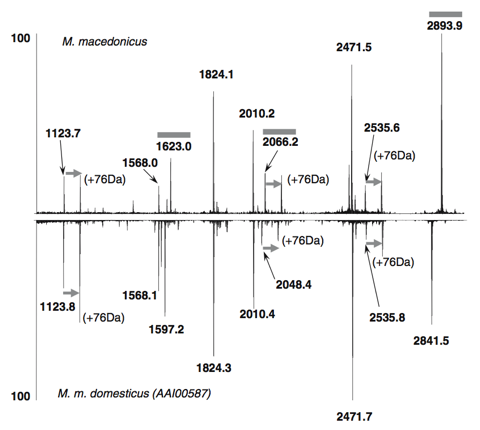MUPs in an aboriginal mouse

Robertson, D.H.L., Hurst, J.L., Searle, J.B., Gunduz, I. & Beynon, R.J. (2007) Characterization and Comparison of Major Urinary Proteins from the House Mouse, Mus musculus domesticus, and the Aboriginal Mouse, Mus macedonicus. J. Chem. Ecol. 33, 613-630.[PUBMED][PDF]
Urine from the house mouse, Mus musculus domesticus, contains a high concentration of major urinary proteins (MUPs), which convey olfactory information between conspecifics. In wild populations, each individual expresses a different pattern of around 8 to 14 electrophoretically separable MUP isoforms. To examine whether other Mus species express MUPs and exhibit a similar level of individual heterogeneity, we characterized urinary proteins in urine samples from an aboriginal species, Mus macedonicus, captured from different sites in Turkey. Anion exchange chromatography and electrospray ionization mass spectrometry demonstrated that M. macedonicus urine contained a single major peak of mass 18,742 Da, and in contrast to M. m. domesticus, all individuals were the same. The M. macedonicus masses were not predicted from any known MUP gene sequence. Endoproteinase Lys-C (Lys-C) digestion of the purified M. macedonicus urinary protein followed by matrix assisted laser desorption time of flight (MALDI-TOF) mass spectrometry demonstrated that it shared considerable, but not complete, sequence homogeneity with M. m. domesticus MUPs. Three M. macedonicus Lys-C peptides differed in mass from their M. m. domesticus counterparts. These three peptides were further characterized by tandem mass spectrometry. The complete sequences of two were determined, and in conjunction with methyl esterification, the amino acid composition of the third was inferred, and the sequence narrowed down to three permutations. The complete M. macedonicus sequence contained a maximum of seven amino acid substitutions, discernible by tandem mass spectrometry, relative to a reference M. m. domesticus sequence. Six of these were on the surface of the molecule. Molecular modeling of the M. macedonicus sequence demonstrated that the amino acid substitutions had little effect on the tertiary structure. The differences in the level of heterogeneity between the two species are discussed in relation to their environment and behavior. In addition, the differences in protein structure allow speculation into molecular mechanisms of MUP function.